Explore Osaka - Japan Travel, Asia
Osaka stands as a cultural and economic powerhouse in Japan, renowned for its warm hospitality and dynamic cityscape. From traditional temples to futuristic skyscrapers, every corner of Osaka tells a story of resilience and innovation. Located in Honshu Prefecture and only takes a short time to travel from Tokyo, Osaka is the dream destination for first-time visitors. Whether you're drawn by its iconic culinary delights, rich cultural heritage, or bustling urban life, Osaka promises an unforgettable experience year-round.
Seeking a tailored Japan adventure? Explore our premium Japan tour offerings here.
Population: Approximately 2.7 millions in 2020.
Economy: Japan’s second largest economic center.
Landmarks: Famous for Osaka Castle, Umeda Sky Building, and Shitennoji Temple.
Japan
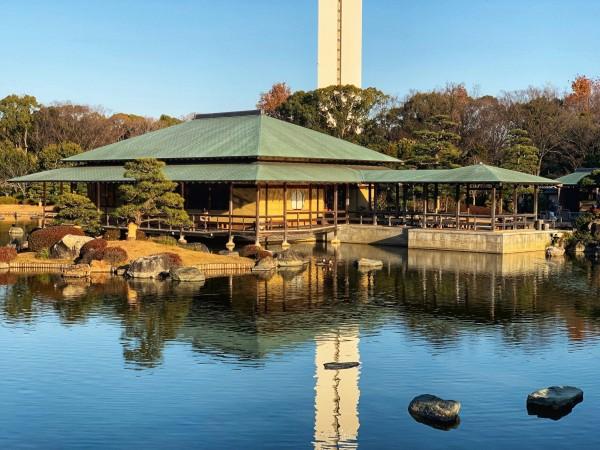
Overview on Osaka
History & Culture Influence
Osaka's history as a prominent castle town and merchant city during the feudal era shaped its distinct culture and identity. Explore remnants of samurai residences and merchant quarters that offer glimpses into Osaka's past glory. Today, Osaka continues to thrive as a center of innovation and commerce, blending modernity with tradition. From cutting-edge architecture to vibrant entertainment districts, the city embraces progress while preserving its cultural heritage.
Interaction with The Locals
Osaka's population embodies a unique blend of traditional Japanese values and modern urban lifestyles. They take pride in their city's rich cultural heritage and culinary prowess, often seen in their love for good food and lively street festivals. Osaka people are also renowned for their directness and outgoing nature, making interactions with visitors memorable and engaging. Their hospitality extends beyond mere politeness, creating a vibrant and inclusive atmosphere that reflects Osaka's status as a dynamic cultural hub in Japan.
Top Attractions in Osaka
- Osaka Castle: A historic symbol of Osaka with impressive architecture, beautiful gardens, and historical exhibits.
- Umeda Sky Building: Offers panoramic views of Osaka from its Floating Garden Observatory, especially stunning at sunset.
- Shitennoji Temple: Japan's oldest Buddhist temple, featuring a five-story pagoda and serene grounds.
- Dotonbori: Famous for its lively atmosphere, neon lights, and delicious street food like takoyaki and okonomiyaki.
- Osaka Aquarium Kaiyukan: One of Japan's largest aquariums, showcasing diverse marine life including whale sharks.
Visitors can explore Osaka's off-beaten-path attractions, from quaint neighborhoods with traditional architecture to local markets brimming with culinary delights and handmade crafts on food. These hidden gems offer authentic experiences away, perfect for curious travelers seeking authenticity and provide you a great chance to immerse yourself in the daily life of the locals.
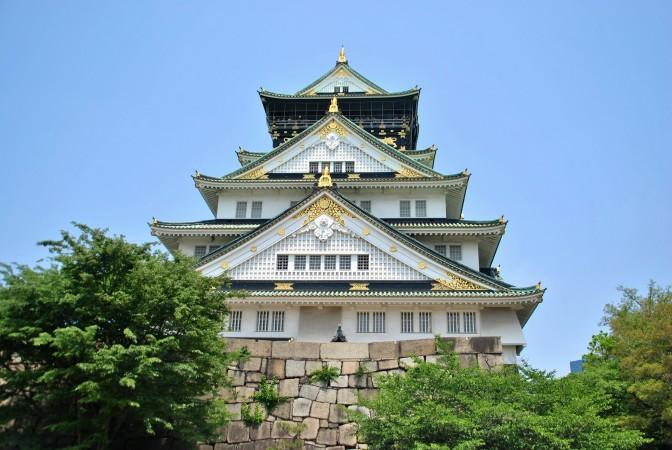
Osaka Castle - © Stefan K
Must-Try Dishes in Osaka
- Okonomiyaki: A savory pancake filled with ingredients like cabbage, pork, and seafood, grilled and topped with savory sauces.
- Takoyaki: Octopus-filled batter balls, crispy on the outside and soft on the inside, drizzled with sweet and savory sauces.
- Kushikatsu: Skewered and deep-fried delights ranging from meats like pork and chicken to vegetables, dipped in a tangy sauce.
- Udon and Soba: Osaka is known for its delicious noodle dishes, including thick udon noodles served hot or cold, and buckwheat soba noodles often enjoyed with dipping sauces.
- Fugu: The infamous blowfish, meticulously prepared by licensed chefs to ensure its safe consumption, often served as sashimi or in hot pot dishes.
- Horumon: Grilled or pan-fried offal meats, including beef and pork intestines, seasoned and served with dipping sauces.
- Kaiseki: A traditional multi-course meal featuring meticulously prepared dishes that highlight seasonal ingredients and artistic presentation.
- Izakaya Delights: Small plates and snacks enjoyed with drinks in cozy taverns, offering a wide range of dishes from grilled skewers (yakitori) to simmered stews (nikujaga).
Explore the unique charm of Kanazawa, another must-visit place in Japan, in our article here.
Festivals & Local Celebrations
Tenjin Matsuri
Join locals in celebrating Osaka's largest summer festival, Tenjin Matsuri, held annually in July. Witness vibrant processions of boats along the Okawa River, dazzling fireworks displays, and performances that showcase Osaka's cultural vibrancy.
Hanami at Osaka Castle
During cherry blossom season in spring, Osaka Castle becomes a popular spot for hanami (flower viewing) picnics under blooming sakura trees. Join the festive atmosphere as locals and visitors alike gather to appreciate the ephemeral beauty of cherry blossoms.
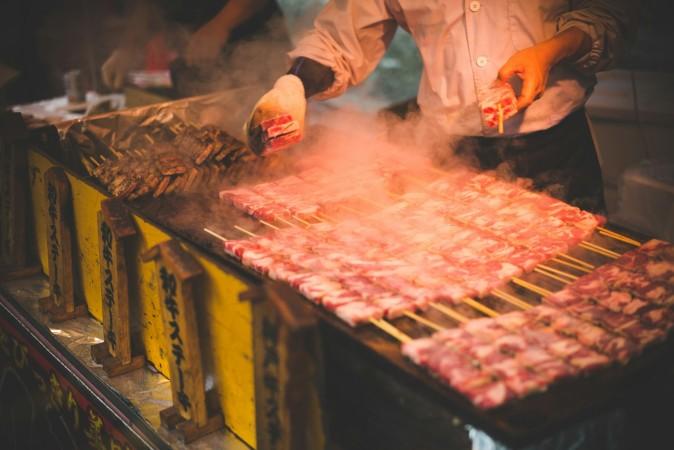
Kushikatsu in Osaka - © Michael Lee
What to Do in Osaka
- Osaka Castle Park: Take a leisurely stroll or enjoy a picnic amidst the scenic beauty of Osaka Castle Park, especially picturesque during cherry blossom season in spring.
- Osaka Museum of History: Dive into Osaka's past at the Osaka Museum of History, where interactive exhibits and panoramic views from the top floor trace the city's evolution from ancient times to the present day.
- Osaka Street Food Tours: Embark on a guided street food tour through districts like Kuromon Ichiba Market or Namba, sampling Osaka's culinary delights such as fresh seafood, regional sweets, and savory snacks prepared right before your eyes.
- Osaka Bay Cruise: Cruise along Osaka Bay aboard a sightseeing boat, enjoying views of iconic landmarks like the Osaka Aquarium Kaiyukan, Tempozan Harbor Village, and the futuristic architecture of the Osaka Maritime Museum.
Shopping in Osaka
Shopping in Osaka is a delight for enthusiasts of both luxury and local finds.
- Dotonbori: Iconic neon signs and bustling energy, offers everything from high-end boutiques to quirky souvenir shops.
- Shinsaibashi Arcade: Beckons with its array of fashion retailers and department stores for all convenient goods one could think of.
- Namba Walk and Osaka Station City: Osaka's famous underground shopping malls will give you a wider range to browse a variety of shops, boutiques, and eateries offering everything from fashion to local crafts.
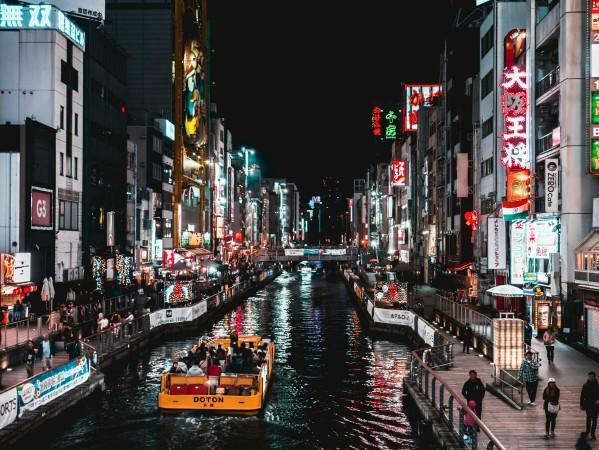
Osaka Bay Cruise - © Ramon Kagie
Weather Conditions in Osaka
Spring (March to May)
- Weather: Spring is one of the most popular periods to visit Osaka because of the pleasant temperatures, which range from 10°C to 20°C (50°F to 68°F). Cherry blossoms bloom from late March to early April, attracting visitors for hanami (flower viewing) picnics.
- Tourism Trend: Peak season for tourism as travelers flock to witness the stunning cherry blossoms in parks and gardens across the city. Accommodation and attraction bookings may require advance planning due to high demand.
Summer (June to August)
- Weather: Osaka has hot and humid summers with average temperatures ranging from 25°C to 35°C (77°F to 95°F). The occasional rain shower provides reprieve from the heat.
- Tourism Trend: Despite the heat, summer sees a steady influx of tourists, especially families and international visitors enjoying summer vacations. Popular attractions like Universal Studios Japan and Osaka Aquarium Kaiyukan are crowded during this period.
Autumn (September to November)
- Weather: Autumn in Osaka brings cooler temperatures ranging from 15°C to 25°C (59°F to 77°F), along with vibrant foliage from late October to November.
- Tourism Trend: Ideal weather for sightseeing and outdoor activities, with fewer crowds compared to spring and summer. The autumn foliage in parks like Osaka Castle Park and Minoo Park attracts nature enthusiasts and photographers.
Winter (December to February)
- Weather: Osaka experiences mild winters with temperatures averaging from 5°C to 10°C (41°F to 50°F). It rarely snows in Osaka, but temperatures can drop, especially in January and February.
- Tourism Trend: Winter sees a decrease in tourist numbers compared to other seasons, making it an excellent time to explore Osaka's indoor attractions, shopping districts, and enjoy seasonal events like illuminations and winter festivals.
Are you interested in Okayama? Discover more about this unique destination with our article here.
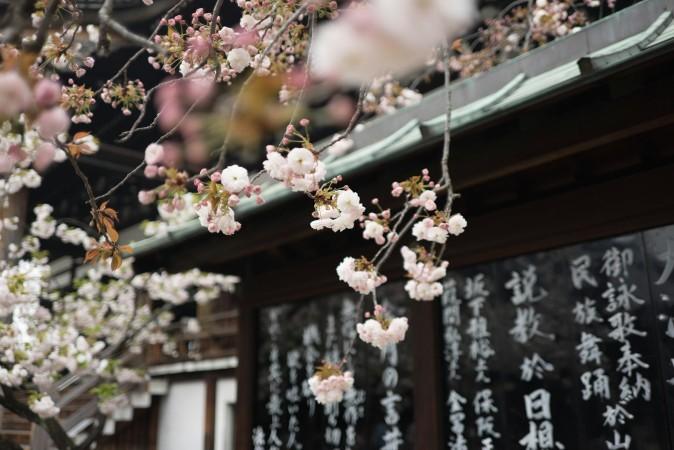
Cherry Blossom in Osaka - © Galen Crout
Culture Etiquette in Osaka
Understanding and respecting cultural etiquette is essential when visiting Osaka, as it enhances interactions with locals and fosters a positive experience.
Respect for Others
- Politeness: Osakans value politeness and courtesy in interactions. Always greet others with a bow or a nod, especially when meeting someone for the first time or entering a shop or restaurant.
- Quietness: Public spaces such as trains, buses, and waiting areas are generally quiet. Maintain the peaceful environment by avoiding having loud talks or using the phone in certain scenarios.
Dining Customs
- Table Manners: When dining in Osaka, it's customary to say "itadakimasu" (I gratefully receive) before a meal and "gochisousama deshita" (thank you for the meal) afterward. Use chopsticks correctly; never place them vertically in food, as this mimics a burial ceremony.
- Slurping: In noodle shops, slurping noodles is acceptable and indicates that you're enjoying the meal.
Social Customs
- Personal Space: Respect personal space and avoid unnecessary physical contact. Osakans appreciate maintaining a comfortable distance during conversations and interactions.
- Gift Giving: When giving gifts, use both hands to present the gift, and it's customary to receive gifts with both hands as well. Gifts are often exchanged at the beginning or end of a visit or business meeting.
- Dress Code: While Osaka is modern and cosmopolitan, modesty in dress is generally appreciated, especially when visiting temples or traditional settings.
Public Behavior
- Queueing: Always queue in an orderly manner, whether waiting for public transport, entering a store, or purchasing tickets. Cutting in line is considered rude.
- Trash Disposal: Japan is known for its cleanliness. Dispose of trash properly and separate recyclables following local guidelines.
Cultural Sensitivity
- Shoes Off: In many homes, traditional accommodations, and some restaurants, you may be required to remove your shoes before entering. Look for shoe racks or take cues from others.
- Language: Learning a few basic Japanese phrases like "hello" (konnichiwa), "thank you" (arigatou gozaimasu), and "excuse me" (sumimasen) shows respect and can help in everyday interactions.

Osaka's Street - © Masahiro Miyagi
Essential Travel Information
Getting Around Osaka
Getting around Osaka is seamless thanks to its efficient transportation network. The city boasts extensive subway and train lines, easy to navigate with an ICOCA card—a convenient touch-and-go payment system used for tourists to simplify the travel experience. Buses and taxis are also readily available, providing flexibility for exploring both within the city and beyond.
ATM & Banking Services
Travelers to Osaka need not worry about access to banking services. ATMs are widely available, accepting international cards in major areas such as airports, train stations, and shopping districts. Currency exchange facilities are also easily accessible, ensuring convenience for visitors from abroad.
Where to Stay in Osaka
Osaka caters to every traveler's accommodation preferences with a diverse range of options. From luxurious hotels boasting panoramic city views in Umeda to budget-friendly hostels nestled in vibrant neighborhoods like Namba, finding a comfortable place to stay is effortless. For those seeking a more immersive experience, traditional ryokans offer a glimpse into Japanese hospitality with tatami-matted rooms and communal baths.
Articles for you

Explore Yala National Park - Sri Lanka Travel, Asia
Tucked away in Sri Lanka’s southeastern corner, Yala National Park is where wild nature meets deep tradition. Known worldwide for its leopard population, the park is also home to elephants, sloth bears, crocodiles, and hundreds of bird species. Beyond wildlife, Yala opens doors to a cultural landscape dotted with ancient temples, Buddhist ruins, and coastal villages. For travelers seeking more than just a safari, Yala offers a chance to explore eco-tourism, local communities, and sacred heritage sites.
Population: The Yala National Park area doesn’t have a human population.
Economy: The economy around Yala National Park thrives on a blend of eco-tourism, agriculture, and local services. Safari tours, eco-lodges, and cultural experiences drive steady income for nearby towns like Tissamaharama and Kataragama, supporting thousands of families.
Landmarks: Famous for Block I of Yala and wildlife encounters, including elephants, sloth bears, crocodiles, and exotic bird species.

Explore Galle - Sri Lanka Travel, Asia
Nestled on Sri Lanka’s southern coastline, Galle is a vibrant city where history meets the sea. Its cobbled streets, colonial architecture, and serene beaches make it a must-visit destination for travelers seeking a blend of culture, adventure, and relaxation. A UNESCO World Heritage site, Galle captivates visitors with its Dutch Fort, bustling markets, and friendly locals. Whether you’re exploring the ramparts at sunset or savoring fresh seafood by the shore, Galle promises an unforgettable journey into Sri Lanka’s heritage.
Population: Approximately 113,000 in 2023.
Economy: Galle’s economy thrives on tourism, trade, and fisheries. The city’s historic fort, colonial architecture, and coastal charm draw thousands of international visitors each year, making tourism its main economic driver. Fishing remains vital for local livelihoods, supplying fresh seafood across the region.
Landmarks: Famous for the Galle Fort, Dutch Reformed Church & Maritime Museum, and Unawatuna Beach.

Explore Bentota - Sri Lanka Travel, Asia
Nestled along Sri Lanka’s southwestern coast, Bentota is a tropical paradise that blends golden beaches, vibrant culture, and thrilling adventures. Famous for its calm waters, luxury resorts, and scenic river estuary, Bentota has become a top destination for travelers seeking both relaxation and authentic experiences. From serene beach walks at sunrise to adrenaline-pumping water sports, this coastal town offers a perfect balance of leisure and exploration. With its proximity to Colombo and Galle, Bentota is easy to reach, making it an ideal stop for both short escapes and extended holidays.
Population: Approximately 37,000 in 2023.
Economy: Bentota’s economy thrives mainly on tourism, which drives local businesses such as hotels, restaurants, and wellness retreats. The town also benefits from fishing, coconut cultivation, and handicrafts like wood carving and batik textiles. Many residents rely on the growing demand for water sports and Ayurvedic treatments, making tourism the backbone of both income and employment in the area.
Landmarks: Famous for Bentota Beach, Bentota River Safari, and Kande Vihara Temple.

Explore Mirissa - Sri Lanka Travel, Asia
Mirissa is a charming coastal town on Sri Lanka’s southern shoreline. Known for its golden beaches, turquoise waters, and vibrant marine life, it has become a must-visit stop for travelers exploring the island. Many come for whale watching, surfing, and sunset views at Coconut Tree Hill, but Mirissa offers much more than postcard beauty. The fishing boats you see anchored by the bay carry generations of stories. Local traditions, delicious cuisine, and a laid-back rhythm of life shape every visitor’s experience.
Population: Approximately 4,700 in 2023.
Economy: Mirissa’s economy is largely shaped by its coastal location. Fishing has long been the backbone of local livelihoods, with generations relying on the Indian Ocean for income. In recent decades, tourism has become the main driver of growth, thanks to whale watching, surfing, and beachside hospitality.
Landmarks: Famous for Mirissa Beach, Coconut Tree Hill, and Parrot Rock Bridge.

Explore Nuwara Eliya - Sri Lanka Travel, Asia
Tucked away in the Central Highlands of Sri Lanka, Nuwara Eliya is often called “Little England”. With its rolling tea plantations, cool misty mornings, and colonial charm, this mountain town feels like a step into another world. Travelers come here to breathe fresh air, walk through flower gardens, sip the finest Ceylon Tea, and enjoy a pace of life far from the island’s busy cities. Whether you’re drawn by scenic landscapes, heritage architecture, or the warmth of its people, Nuwara Eliya is a destination that blends nature, culture, and history in perfect harmony.
Population: Approximately 781,000 in 2023.
Economy: Nuwara Eliya’s economy thrives mainly on tea production, as it sits in the heart of Sri Lanka’s central highlands, famous worldwide for Ceylon Tea. The city also benefits from a growing tourism industry, attracting visitors with its colonial charm, cool climate, and scenic landscapes.
Landmarks: Famous for Gregory Lake, Hakgala Botanical Garden, and Victoria Park.

Explore Sukau - Malaysia Travel, Asia
Nestled on the banks of the Kinabatangan River in Sabah, Malaysian Borneo, Sukau is a destination where wildlife, culture, and conservation come together. Known as one of Asia’s top spots for river safaris and eco-tourism, this quiet village offers a front-row seat to encounters with Bornean orangutans, pygmy elephants, proboscis monkeys, and exotic birdlife.
Population: Approximately 1,400 in 2019.
Economy: Sukau’s economy is shaped by its riverine location and natural resources. Traditionally, the Orang Sungai community relied on fishing, small-scale farming, and forest gathering for their livelihood. Today, the village has shifted toward eco-tourism, with river cruises, jungle trekking, and homestays providing income.
Landmarks: Famous for the Kinabatangan River cruises, Gomantong Caves, and Ox-bow lakes and wetlands.
